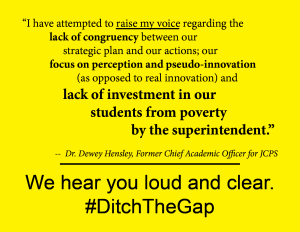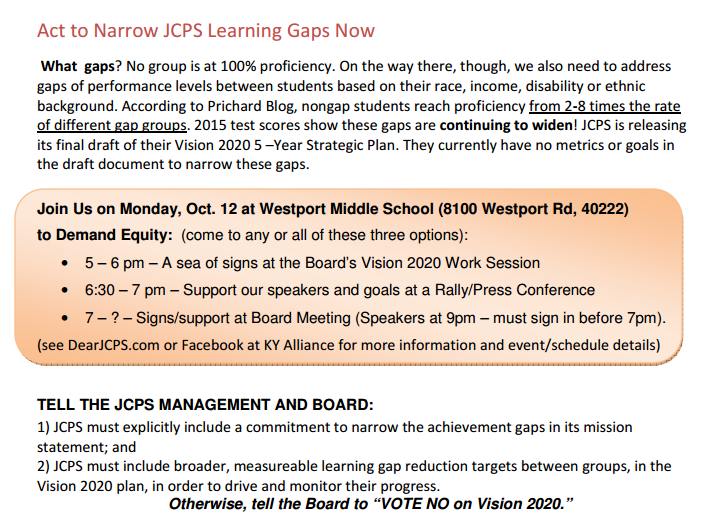This is the speech given by Gay Adelmann to the JCPS Board of Education on Nov. 9, 2015.
Every time I’ve spoken to the board it’s been to bring constructive and helpful feedback to light because attempts to have stakeholder input and concerns heard were being dismissed.
Listening to the work sessions tonight and even the interviews yesterday and today it remains clear that there is still a tendency to minimize feedback and concerns. You appear to have the perception that these incidents are isolated.
These are not new. These are not isolated. These are systemic problems. Info only flows one way and stakeholders continue to not be heard. The existence of this dynamic and the number of people we encountered who felt the same is why we started Dear JCPS. We started this group because problems continue to escalate in the district and we’ve heard from stakeholders who tried to bring solutions, concerns and ideas forward and are ignored, or worse, treated as the enemy. It’s frustrating when we see events that could have been mitigated if only this feedback had been considered.
Which brings me to my reason for being here tonight. I am concerned that the legislative agendas goal to extend power to the superintendent further isolates stakeholders from the decision making process. Sup already leads the committee and has a vote. Says she needs this power in order to assign a principal who might not apply for a position. I ask how has this additional power helped her with priority schools which she already has this power over? How does she not have the ability to do this collaboratively? Why does she need the final decision?
I would like to encourage you to proceed with caution when taking any further stakeholder power away. As an example of a priority school where this power already exists. Dr Hargens has chosen our last two principals and I’ve watched more and more staff leave every year. Relationships matter. However we have the highest staff turnover in the district. I can only count 8 people who were there when my son started 3 1/3 years ago. We’ve had 16 or 17 teachers leave this year. Stakeholder and SBDM feedback were solicited but not employed. We wanted consistency. We had highly qualified internal candidates identifies. Our principal was named the day before school started.
I argue that a well trained SBDM that is intimately familiar with the schools culture, population, needs, history, challenges, goals, and day to day happenings is more highly equipped to make better decisions at the local level than someone who oversees 171 schools that are all different and unique in their challenges. What worked elsewhere does not necessarily work here.
We have bigger fish to fry before taking more power away from stakeholders. Let’s work on improving the situations for the schools the sup already has power over before expanding that power district wide.
Leave the final decision at the school level where the accountability is held. Listen to teachers. They are the ones doing the work and know what we need. Give schools the ability to control their own destiny not suffer consequences year after year from decisions they did not make. Keep the final decision at the school level because they are the ones directly responsible for serving the students. They are the ones who ultimately pay the price.

 vate messages, and in person visits. We plan to research and vet that information into concise message points for the board to consider.
vate messages, and in person visits. We plan to research and vet that information into concise message points for the board to consider.

